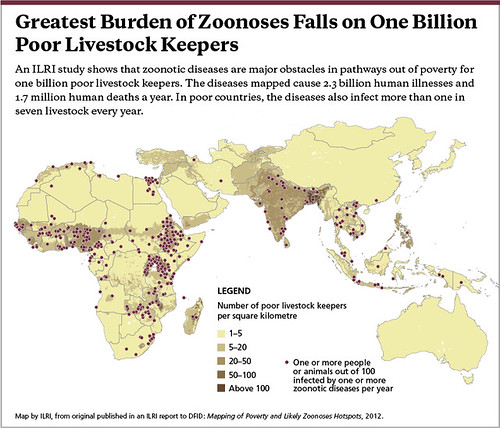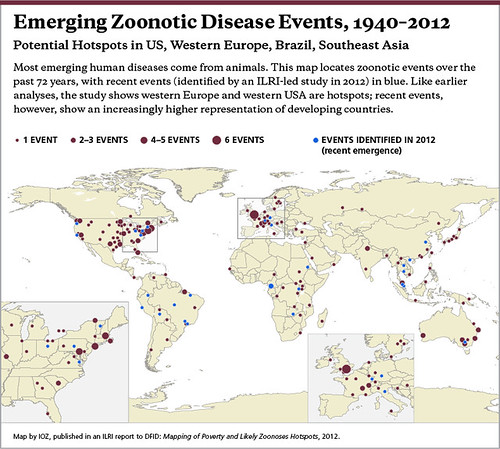A new international study has published a “top 20” list of geographical hotspots for human-animal diseases (zoonoses) , such as tuberculosis (TB) and Rift Valley fever. According to the study, conducted by the International Livestock Research Institute (ILRI), the Institute of Zoology (UK) and the Hanoi School of Public Health in Vietnam, 13 zoonoses are responsible for 2.4 billion cases of human illness and 2.2 million deaths every year.
A zoonose, or zoonosis is any kind of infectious disease that can be transmitted from animals to humans and vice-versa. Sometimes the human-to-animal transmission is called “reverse soonosis” or “anthroponosis”.
Delia Grace, a veterinary epidemiologist and food safety expert with ILRI in Kenya and lead author of the study explained:
“From cyst-causing tapeworms to avian flu, zoonoses present a major threat to human and animal health. Targeting the diseases is the hardest hit countries is crucial to protecting global health as well as to reducing severe levels of poverty and illness among the world’s one billion poor livestock keepers.
Exploding global demand for livestock products is likely to fuel the spread of a wide range of human-animal infectious diseases.”
The top four countries regarding zoonotic disease burdens, with widespread morbidity and mortality are:
- India
- Ethiopia
- Tanzania
- Nigeria
In addition, the team found that Western Europe (especially the UK), parts of Southeast Asia, and the northeastern United States may be hotspots of “emerging zoonoses.”
Emerging zoonoses are those that are newly virulent, have recently become drug resistant, or are newly infecting humans.
The study, which receiving funding from the United Kingdom’s Department for International Development (DFID), also found that around 60% of all human diseases and 75% of all emerging infectious diseases are zoonotic.
Around the world, 2.5 billion people currently survive on less than US$2 per day. As a result, many people depend on livestock for their food, income, traction, manure or other services.
Despite the danger of zoonoses, the global demand for meat and milk products is on the rise and provides a big opportunity for poor livestock keepers.
Steve Staal, deputy director general-research at ILRI, explained:
“Increased demand will continue over the coming decades, driven by rising populations and incomes, urbanization and changing diets in emerging economies. Greater access to global and regional meat markets could move millions of poor livestock keepers out of poverty if they can effectively participate in meeting that rising demand.”
According to the researchers, brucellosis – which reduces milk and meat production by around 8% – affects approximately 1 in 8 livestock in poor countries.
They note that even though the increasing demand for livestock in the developing world represents a pathway out of poverty for many, the presence of zoonotic diseases can perpetuate instead of lower poverty and hunger in livestock-keeping communities.
The team found a 99% correlation between the burden of zoonoses and country levels of protein-energy malnutrition.
Staal said:
“Many poor livestock keepers are not even meeting their own protein and energy needs. Too often, animal diseases, including zoonotic diseases, confound their greatest efforts to escape poverty and hunger.”
After examining 1,000 surveys involving more than 10 million people, and 6 million animals and 6,000 food or environment samples, the team identified the 14 most important zoonoses.
These zoonoses were prevalent among livestock in developing nations. According to the researchers, at least one-third of global diarrheal diseases are caused by zoonoses. They explain that this type of disease is the biggest zoonotic threat to public health.
John McDermott, director of the CGIAR Research Program on Agriculture for Nutrition and Health, led by the International Food Policy Research Institute (IFPRI), said:
“As production, processing and retail food chains intensify, there are greater risks of food-borne illnesses, especially in poorly managed systems. Historically, high-density pig and poultry populations have been important in maintaining and mixing influenza populations. A major concern is that as new livestock systems intensify, particularly small- and medium-sized pig production, that more intensive systems will allow the maintenance and transmission of pathogens. A number of new zoonoses, such as Nipah virus infections, have emerged in that way.”
According to the researchers, the most rapid changes in pig and poultry farming are expected to occur in India, Myanmar, Pakistan, Burkina Faso, and Ghana.
The team highlight that although bovine tuberculosis is rare in both humans and livestock in developed nations, it still affects around 7% of cattle in poor nations – reducing their production by 6%.
The team’s findings indicate that the burden of zoonotic forms of TB may be underestimated, with bovine TB responsible for up to 10% of human TB cases.
In developing nations, human TB is still one of the leading and most prevalent human diseases. 80% of the 12 million people who suffered from active disease in 2010, lived in developing nations.
The researchers found that zoonoses and animal diseases in poor countries are being “massively” underreported. 99.9% of all livestock losses in sub-Saharan Africa are never registered in official disease reports. “Surveillance is not fulfilling its purpose”, they added. Today’s surveillance problem will grow as the climate changes.
What do these countries have in common?
- They have the highest burden of zonoses
- They have the highest number of livestock keepers
- They have the highest number of malnourished people
- They are among the top five countries for both absolute numbers affected with zoonoses and relative intensity of zoonoses infection
Grace explained:
“These findings allow us to focus on the hotspots of zoonoses and poverty, within which we should be able to make a difference.”
The most important zoonoses in terms of human health impact, livestock impact
(Source: World Health Organization)
- Anthrax
- Avian influenza
- Bov. Spongiform Encephalopathy
- Brucellosis
- Buffalo pox
- Chagas
- Chickungunya
- Clostridium difficile disease
- Cysticercosis
- Dengue fever
- Ebola
- Echinococcosis
- Gastrointestinal (zoonotic)
- Hanta disease
- Hepatitis E
- Japanese encephalitis
- Leishmaniasis
- Leptospirosis
- Psittacosis
- Q fever
- Rabies
- Rift Valley fever
- Toxoplasmosis
- Trypanosomosis (zoonotic)
- Tuberculosis (zoonotic)
Written by Grace Rattue

